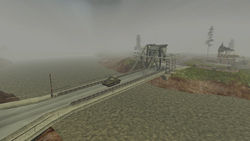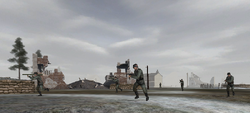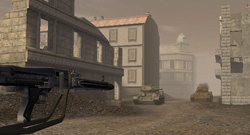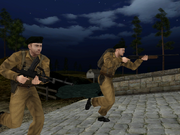World War II (often abbreviated as WWII or WW2, also known as the Second World War or, on the Eastern Front, the Great Patriotic War) was a global conflict lasting from 1939 to 1945, involving most of the world's nations including all of the great powers, eventually forming two opposing military alliances, the Allies and the Axis. It was the most widespread war in history, with more than 100 million military personnel mobilized. In a state of "total war," the major participants placed their entire economic, industrial, and scientific capabilities at the service of the war effort, erasing the distinction between civilian and military resources. Marked by significant events involving the mass death of civilians, including the Holocaust and the only use of nuclear weapons in warfare, it was the deadliest conflict in human history, resulting in 50 million to over 70 million fatalities.
Background
After World War I and the failure of the Weimar Republic, Germany was left in ruins. Within the early 1930s, Adolf Hitler became the Chancellor (later Führer) of the central European country. For Italy in the 1920s, Benito Mussolini rose to power. In 1931, Japan used its army to invade northern China and by 1937, the whole of the eastern Asian mainland. By 1938, the Germans peacefully annexed the Sudetenland and Austria after Italian forces took Ethiopia in 1935. Ignoring a peace-time conference in Munich, Hitler gradually took all of Czechoslovakia a year after. With new weapons tested in the Spanish Civil War in 1936-1939, Hitler's next target was Poland.
In order to take half of the country, he persuaded Joseph Stalin, the Premier of the Soviet Union, to secure a treaty under which the Red Army would take the other half of Poland. On September 1, 1939, Germany invaded Poland with a tactic that became known as the Blitzkrieg. Two days later, the British and French governments declared war on the Germans which caused a retreat from France a year later by the British when they were overrun.
European Theater
Italian Campaign
July 9, 1943 - May 5, 1945
The Italian Campaign appears in Battlefield 1942: The Road to Rome. Northern Italy was a battleground in World War I, but by the Second World War, Italy had to defend its homeland after Hitler's Afrika Korps were destroyed in Tunisia on May 13, 1943. On July 9, Operation Husky commenced in which the Allies took on the Royal Italian Army for a month and thirty-nine days.
Operation Husky
July 9 – August 17, 1943
Operation Husky was a major conflict in the Italian campaign, in which the Allies took Sicily from the Axis Powers. It was a large scale amphibious and airborne operation. followed by six weeks of land combat. During the first hours of the operation, the British Army launched their airborne forces near the coastal town of Syracuse to seize landing zones from the Royal Italian Army. Hours later, the infantry came ashore in landing craft to assist the paratroopers.
Operation Baytown
September 3 - 9, 1943
Operation Baytown was the amphibious assault across the Messina strait, between Sicily and Calabria. The British Army was tasked to seize bridges across the strait and push into Italy; however, the Royal Italian Army, on the brink of surrender, had one final objective - to destroy the bridges. Following the defeat, Italy surrendered and the Allies launched Operation Avalanche.
Battle for Salerno
September 9 - 15, 1943
The Battle for Salerno was part of Operation Avalanche. The Invasion of Italy, the battle was a cooperative attack from both Allied forces; the British Army would seize the port of Salerno itself, while the United States Army secured the mountains of Paestum. Victory assured the Allied forces of a secured western flank in the offensive in South Italy.
Battle for Monte Cassino
January 17 – May 18, 1944
The Battle for Monte Cassino was a series of bloody battles carried out by the United States Army, British Army, and the Free French Forces, the US and British forces were pushed off the hill previously and the Free French Forces secured the hill after four consecutive battles on Monte Cassino.
Battle for Anzio
January 22 – June 5, 1944
The Battle for Anzio was part of Operation Shingle, the United States Army tasked of bypassing the Gustav Line in hopes of outflanking the Wehrmacht forces from the rear, Anzio was the landing section where the US would land. As the assault began, Italian troops, now formed as the Italian Social Republic, began engaging American forces.
The Battle of Monte Santa Croce
August 25 - December 17, 1944
The Battle for Monte Santa Croce was part of Operation Olive. With the Allied forces having starting a second front in Northern France, the Italian Campaign has now turned into a sluggish drive to the Alps, Free French Forces attempt to secure the High Mountains of Monte Santa Croce. Despite heavy losses both sides abandoned the mountains and fought for them another day. Operation Olive ended after the capture of Bologna in December 1944. By this time, Allied forces in France were securing their way into Germany to end the war.
Western Front
The Western Front of World War II was generally restricted to the same geographic regions as during World War I. During the war, the front moved much further, as far west as the English Channel and deep in to the Soviet Union to the east. Although fighting took place in Norway and Italy, these are not usually included as part of the Western Front but as separate campaigns.
Battle of Britain
July 10 – October 31, 1940
The Battle of Britain was an air campaign waged by the Luftwaffe against the United Kingdom during the summer and autumn of 1940. The objective of the campaign was to gain air superiority over the Royal Air Force, especially Fighter Command. The name derives from a famous speech delivered by Prime Minister Winston Churchill in the House of Commons: "...the Battle of France is over. I expect that the Battle of Britain is about to begin."
The Invasion of Normandy
June 6 – August 25, 1944
Omaha Beach
June 6, 1944
Omaha Beach is the code name for one of the five sectors of the Allied invasion of German-occupied France in the Normandy landings. The beach is located on the coast of Normandy, France, facing the English Channel, and is 5 miles (8 km) long, from east of Sainte-Honorine-des-Pertes to west of Vierville-sur-Mer on the right bank of the Douve River estuary. Landings here were necessary in order to link up the British landings to the east at Gold Beach with the American landing to the west at Utah Beach, thus providing a continuous lodgement on the Normandy coast of the Bay of the Seine. Taking Omaha was to be the responsibility of United States Army troops, with sea transport provided by the United States Navy and elements of the Royal Navy.
The Battle for Carentan
June 10 - 13, 1944
The Battle for Carentan was a joint airborne and land battle, airborne forces were dropped behind enemy lines and were tasked of taking the crossroad town of Carentan, the United States Army coming from Omaha Beach were tasked of linking up with them to secure the town. To reach the town, US forces had to fight through the Bocage, an interlinked network of hedgerows, which were ideal defending locations for German forces.
Liberation of Caen
June 6 – August 6, 1944

A Canadian Sherman tank crosses Pegasus Bridge during the Battle for Caen.
The Battle for Caen took place from June to August of 1944 and was a battle between Allied forces primarily consisting of British and Canadian troops and German forces during the Invasion of Normandy.
Invasion of Germany
August 25, 1944 - April 25, 1945
Operation Market Garden
September 17 - 25, 1944
Operation Market Garden was an Allied military operation, fought in the Netherlands and Germany. It was the largest airborne operation up to that time. It consisted of three Airborne divisions dropping on Dutch towns and bridges and securing them for the armored corps that would drive over said bridges and into Germany. The operation had a terrific start; however, increasing presence of German armor eventually forced the operation to slowly grind to a halt.
Battle of the Bulge
December 16, 1944 – January 25, 1945

Wehrmacht infantry during the Battle of the Bulge.
The Battle of the Bulge was a major German offensive, launched toward the end of the war through the densely forested Ardennes mountain region of Wallonia in Belgium, hence its French name, Bataille des Ardennes, and France and Luxembourg on the Western Front. The Wehrmacht's code name for the offensive was Unternehmen Wacht am Rhein ("Operation Watch on the Rhine"), after the German patriotic hymn Die Wacht am Rhein. This German offensive was officially named the Ardennes-Alsace campaign by the United States Army, but it is known to the English-speaking general public simply as the Battle of the Bulge, the "bulge" being the initial incursion the Germans put into the Allies' line of advance, as seen in maps presented in contemporary newspapers.
Eastern Front
On the first day of October, Germany forces were encountered by the Soviets at Kharkov trying to get hold of three major outposts in the ruined city. As the battle continued, Stalingrad and Kursk became heavily bombarded by German artillery. On August 23, 1943, the Soviets had won the two battles against the Germans.
Battle of Kharkov
October 20 - 24, 1941
The First Battle of Kharkov only lasted four days, as it was a great surprise to the Red Army and their unprepared defenses. German tanks rolled over the defenses and battled in close quarters fighting on the western edge of the city. By the fourth day, the Soviets were overwhelmed and evacuated the city.
May 12 - 28, 1942
The Second Battle of Kharkov lasted 16 days as an attempt to ambush the Germans on their way to Rostov-on-Don. Soviet losses were high, but Kharkov was nearly captured. In the final days of the offensive the Luftwaffe arrived and halted the Soviets' progress. Soon afterwards, German armor rolled back into the city and beat back the Soviets.
February 19 - March 15, 1943
The Third Battle of Kharkov was a German counter-offensive to restore order in the Stalingrad area. In early February, Soviet troops stormed Kharkov only to realize the city was undefended. Taking advantage of the opportunity, Soviet troops barricaded Kharkov in hopes of stopping the German troops for a third time. However, their efforts proved unsuccessful and heavy German armor and Waffen SS troops stormed the city walls once again and beat back the Soviet defenders.
August 12 - 23, 1943
The Fourth Battle of Kharkov was a part of Operation Polkovodets Rumyantsev, the Soviet counter-offensive in the Kursk region. With Germany's offensive power crippled in Russia, the Soviets were successfully able to storm Kharkov without concern of another German counter-offensive. After the capture of the Dzerzhinksy Square in the center of Kharkov, German troops surrendered and Kharkov was finally liberated.
Battle of Stalingrad
August 23, 1942 - February 2, 1943
The Battle of Stalingrad was a major battle in the war in which Germany and its allies fought the Soviet Union for control of the city of Stalingrad (now renamed Volgograd) in southwestern Russia. The battle took place between August 23, 1942 and February 2, 1943. It was among the largest battle on the Eastern Front and was marked by its brutality and disregard for military and civilian casualties. It was amongst the bloodiest battles in the history of warfare, with the higher estimates of combined casualties amounting to nearly two million. In its defeat, the crippling losses suffered by Germany's military proved to be insurmountable for the war. The battle was a turning point in the war, after which German forces attained no further strategic victories in the East.
Battle of Kursk
July 5 - August 23, 1943
The Battle of Kursk took place when German and Soviet forces confronted each other in the vicinity of the city of Kursk, in the Soviet Union in July and August 1943. It remains both the largest series of armored clashes, including the Battle of Prokhorovka, and the costliest single day of aerial warfare in history. It was the final strategic offensive the Germans were able to mount in the east. The resulting decisive Soviet victory gave the Red Army the strategic initiative for the rest of the war.
The Battle of Berlin
April 16 – May 2, 1945

Soviet T-34s during the Battle of Berlin.
The Battle of Berlin, designated the Berlin Strategic Offensive Operation by the Soviet Union, was the final major offensive of the European Theater of World War II, resulting in the decimation of the German forces and the surrender of Germany. It was one of the bloodiest battles in history.
— German defeat at Berlin, signaling the end of the War in Europe
African Theater
Western Desert Campaign
June 11, 1940 - February 4, 1943
When Italy declared war on Britain and France in June 1940, Italy began its drive towards Cairo and resume its control over the Mediterranean. However, the Royal Italian Army was untrained and lacked the necessary resources to fight the British Army. On December 9, 1940, the British launched Operation Compass and drove the Italians back into Libya. Italy asked Germany for assistance in their campaign and the Afrika Korps arrived in March 1941 under the command of Erwin Rommel. From then on, Britain was pushed back to Egypt.
Siege of Tobruk
April 10 - November 27, 1941
After the arrival of the Afrika Korps in El Agheila, the British Army was back on the retreat towards Egypt. Along the way, they barricaded themselves inside the fortress town of Tobruk. This is when the Siege of Tobruk began. The siege finally ended in November 1941 in British surrender.
Operation Battleaxe
June 15 - 17, 1941
In a desperate attempt to break the Siege of Tobruk, the British Army launched Operation Battleaxe: a long drive along the coastal road from Sidi Barrani and clearing German positions on the Libyan/Egyptian border in areas such as Fort Capuzzo, Musaid, and the Halfaya Pass. British forces would then push through the gap into Tobruk. Unknown to the British Army, the Afrika Korps had sent an armored spearhead to ignore the fort of Tobruk and push onward to Cairo. The British met the Germans head on in an armored clash near the Libyan/Egyptian border. Due to an overwhelming number of resources, tanks, and infantry, the British were forced to retreat, leaving Tobruk in Axis hands.
Battle of Gazala
May 26 - June 21, 1942
After launching Operation Crusader in November 1941, the Afrika Korps was pushed back to El Agheila and needed more resources sent from Germany. As a result, the Afrika Korps recieved new tanks and more equipment including dummy tanks assembled from wool and cloth. Erwin Rommel used these dummy tanks to lure the British Army out into the open, where they would then be engaged by the actual German tanks, thus destroying the British troops. Subsequently, the British were once again pushed back to Egypt. British Intelligence confirmed that due to fast retreat, Germany's supply lines were stretched too far, forcing them to halt the advance. Using this window of opportunity, they prepared defenses along the Gazala Line, and thus the Battle of Gazala ensued. After the Afrika Korps flanked the Gazala Line, the British were forced to retreat back to El Alamein.
Operation Aberdeen
May 29 - June 11, 1942
Operation Aberdeen was the British attempt to stop the Afrika Korps in the open plains near Bir El Harmat, after the initial flank near Bir Hakeim the British Army needed to stop the German drive to Tobruk. Afterwards the British could not take on the sheer number of German tanks and was forced to fallback to defend Sidi Muftah. In the end, Tobruk was captured again in June 1942.
Second Battle of El Alamein
October 23 - November 4, 1942
After the first battle of El Alamein, the battle ended in a stalemate. It did, however, halt the Afrika Korps advance to Cairo, but upon received further supplies, Rommel continued the assault. This was the Second Battle of El Alamein. Rommel struck further into the El Alamein line and taking Kidney Ridge. By this time, a new British commander stepped into play, Bernard Montgomery. Taking command of the British Army in El Alamein, he coordinated defenses and counter-attacked at the right moment, catching the Afrika Korps off guard. From this point on, the Afrika Korps were on the retreat, Rommel having exhausted his supplies and falling back to El Agheila. In December 1942, El Agheila was captured by the British and the Axis forces were forced to retreat into Tunisia. After Operation Torch, the United States Army joined the fight against the Afrika Korps, nearly losing their foothold at the Battle for Kasserine Pass. However, they struck back and assisted in driving the Afrika Korps out of Africa. The Germans surrendered in May 1943 and Africa was securely in Allied hands.
Allied Operations in Europe and North Africa
To help turn the tide of the war in Euro to Allies favor, missions were conducted behind enemy lines to cripple the German war machine. These missions appear in Battlefield 1942: Secret Weapons of WWII.
Raid on Agheila
December 11 - 18, 1942
The raid was conducted by the SAS to cripple the German occupation on the town.
Raid on Telemark Facility
February 16, 1943
The SAS raided a heavy-water test facility in Norway to prevent the Germans from using the substance to create the first atomic bomb to use against the Allies.
Essen
Circa 1944-1945
Gothic Line
Late August 1944 - Early March 1945
Peenemünde
August 25, 1944
The US Army is sent to infiltrate the facility to destroy it in order to prevent the Germans from launching more missiles into places such as London.
Mimoyecques
Circa September 1944
Kbely Airfield

SAS commandos at Kbely Airfield.
March 1945
SAS forces fought the Waffen-SS for the airfield that tried to prevent the SAS's Russian Allies from occupying Eastern Europe.
Hellendoorn
March 22, 1945
Eagle's Nest
Late April 1945
Pacific Theater
With Japan having entered the war in late 1940, their goal was to dominate the Pacific Ocean, which garnered the attention of US and Australian forces. Before beginning their expansion into the South Pacific Sea, they coordinated a series of simultaneous attacks on US-held island territories, such as Guam, Wake Island, and the Philippines. It was crucial to the Japanese that the islands were secured by rendering the United States Navy useless. On December 7, 1941, the US naval base of Pearl Harbor in Oahu, Hawaii was bombarded by aerial and naval strikes by the Imperial Japanese Navy. The following day, December 8, the United States of America declared war on Japan, prompting the Japanese to seize the American home islands as planned.
Battle of Wake Island
December 8 - 23, 1941
After the bombing of Pearl Harbor, the Imperial Japanese Navy proceeded to invade the US territory of Wake Island. The island possessed an airfield, which would be vital for the Japanese campaign for Pacific dominance. The invasion lasted for 20 days and Wake Island was eventually captured. It would be another three years before the US would return to recapture the island.
Philippines Campaign
December 8, 1941 - May 8, 1942
Several hours after the invasion of Wake Island, the Imperial Japanese Army invaded Luzon, commencing the Invasion of the Philippines. Using PT Boats to defend the islands from US destroyers and landing craft, the Japanese broke through American defenses and moved inland. By May 1942, General Douglas MacArthur made a bold promise to return to the island.
October 20, 1944 - September 2, 1945
Two years later, General MacArthur fulfilled his promise with the American assault of the Philippines, expelling the Japanese invaders and securing the islands in its island hopping campaign.
Battle of the Coral Sea
May 4 - 8, 1942
On May 3, 1942, the Imperial Japanese Navy captured the island of Tulagi, surprising the USS Yorktown and USS Lexington in the Coral Sea, which were assault by Imperial Japanese aircraft. The next day, American fighters and bombers took off from the Lexington and Yorktown to hunt down the Japanese carriers Shokaku and Zuikaku, starting the Battle of the Coral Sea. The Shokaku and Zuikaku were heavily damaged, as was the USS Yorktown was critically damaged, although the Lexington would be lost. Tulagi remained firmly in Japanese hands. US and Japanese aircraft carriers would continue the battle at Midway Island.
Battle of Midway
June 4 - 7, 1942
After the Battle of the Coral Sea, Japanese officers saw the small island of Midway, a tiny island with an airfield, which posed a significant threat to the Imperial Japanese Navy. The Japanese brought overwhelming numbers to deal with the small American armed forces stationed on the island, but just as the attack was underway, Japanese scout planes spotted two US aircraft carriers a few miles from Midway, the USS Enterprise and the USS Hornet, along with several destroyers and cruisers. Japanese aircraft carriers launched their bombers and sunk the Hornet and damaged the Enterprise; hours later, the Enterprise launched their own wave of bombers and sunk four Japanese cruisers and aircraft carriers: The Akagi, Kaga, Hiryu, and Soryu. Later, the USS Yorktown was reunited with the Enterprise, despite being repaired in battle. Both US carriers attacked the Japanese one last time and wiped out any remaining enemy forces.
Battle of Guadalcanal
August 7, 1942 - February 9, 1943
After Midway, the United States Navy headed south to Australia to prevent a possible Japanese invasion of Australia. The Solomon Islands were a blockade standing between Australia and the Imperial Japanese Navy. The Japanese needed to take the Solomon Islands to prevent island bombardment on the Japanese landing craft. One island stood in the way of this - Guadalcanal. The IJN and USMC fought over Guadalcanal for six months over key strategic positions like Henderson Airfield, Bloody Ridge, and the Lunga River. Eventually, Japanese forces withdrew from Guadalcanal.
Operation Aurora
October 6, 1944
Operation Aurora was a top secret operation conducted by the Office of Strategic Services (OSS) in conjunction with the United States Marine Corps. The operation's purpose was to seek and gather intelligence on any potential Japanese secret weaponry. Two squads of US Marines were sent in to infiltrate an unknown Japanese home island, although Able squad was immediately spotted and killed. After moving inland, the remaining squad met up with a Japanese defector, who warned them of a high-tech scalar weapon known by the Japanese as "The Black Weapon." Upon retrieving the intel and the defector, the Marines pushed toward a Japanese subpen in order to escape the island. Just as the squad prepared to leave via a captured submarine, the Japanese fired the weapon, which created a massive tidal wave, drowning the Marines and the defector.
Battle of Iwo Jima
February 19 - March 26, 1945
The Battle of Iwo Jima was one of the last and bloodiest battle in the Pacific War. The Marines landed on the beach under intense fire and suffered heavy losses. After hours of intense fire from the Japanese-controlled high ground, the Marines managed to move off the beach and secure the airfield on the island. Hours later, they set out to capture Mount Suribachi. After small skirmishes on the northern section of the island past the airfield, the island was eventually secured by US forces.
| |||||
